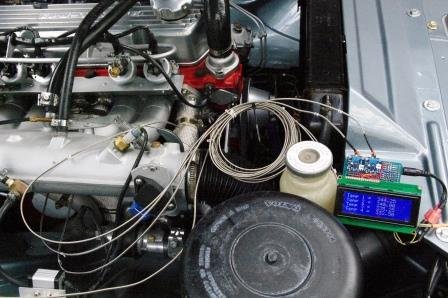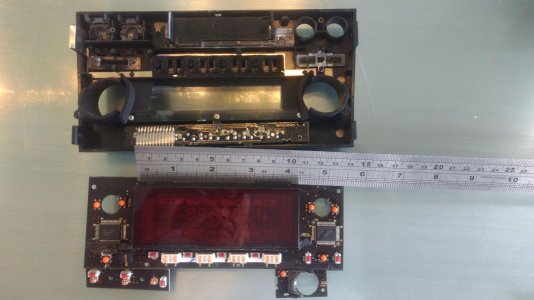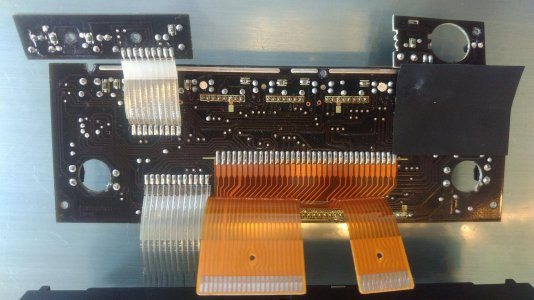I pulled the display board, but not the actual display...it is buried under an acrylic lens. (I'm a CS, not an EE, so any help educating me is appreciated)
The control chips are dual NEC D6700GH (next line down 9039K7) and everything fed through a couple of ribbon cables. Everything else is either a pot (volume, treb/bass)or a momentary switch on other boards or connectors.
The D6700GH is labeled as "a static display driver" and is still being made, or at least knocked off, today. I presume the "static" part is the chip supplying a steady voltage some predefined [shape] that lights up...
So the question is: How do I (somebody) build an interface into this display using a rPi or similar?
I had pulled my head unit apart years ago to clean off something on the inside of the faceplate. Apparently I didn't pay close attention to the details as I assumed that the display was some type of LCD display. Based upon that chip number that chip just appears to be a driver for a fluorescent display. It can accept 48 bits of data and hold that data in a register and use that data to drive up to 47 individual display segments. So, to make use of it, you would have to figure which output pin is driving which segment on the display. 2 x47 = 94 seems like an awful lot of segments for the NSX display. Outputs 1-10 can also be configured to read the data and drive LEDs, so maybe that is why they have two of the chips with one for the LEDs in the buttons. I just glossed over the data sheet, so I am guessing that the status of bits 1-47 drives segments 1-47. The driver requires a micro controller up front to accept data from the radio or CD / cassette / whatever, interpret that data and package it into the 48 bit long data 'thing' that it then dumps to the driver chip to update the individual segments on the display. I am betting that on the main board or the display board that there is a chip like an NEC UPD170xx or UPD7500x which is a NEC micro controller that accepts data from the front end devices and packages it into the 48 bit long package that drives the display.
If the display is unique to the NSX or other Alpine devices, figuring out which data bit drives what segment would be a bit of work. I expect that you could do it experimentally by setting up a micro controller to dump the 48 bit long data 'things' to the display driver and see which bit lights up what segment. This would allow you to create a map for the display. Doable; but, not a trivial exercise.
People have mentioned using software definable radios. They are available and can do AM and FM; but, as far as I am aware don't do AM below about 20 Mhz so are not usable with the AM broadcast stations in North America. You can get Wi Fi / Bluetooth radios to bind to your telephone and stream audio to the head unit. Of course, with the existing display, any identifying data that comes with the content is not displayable on the existing head units predefined display. Essentially the same problem with using flash RAM on a Grom with the existing NSX head unit - it only supports 6 CDs / directories with up to 99 files in a directory.
There are lots of nifty displays out there. Unfortunately, the form factors for the nifty ones that I have seen don't exactly match up with the NSX display according to your measurements. I used a 44780 LCD display when I hooked up some probes to measure EGTs on another car.

The display is 3.8 " long, so slightly smaller than the NSX display according to your photo. It has 4 lines of 20 5x7 characters so quite readable and can probably be configured to replicate everything on the NSX display (a little coding required for non standard characters). The display is available in RGB so you should be able to match the NSX display color. I had white on blue because it is easy to read. The software libraries to drive the display are readily available for Arduino / Teensy / .......








